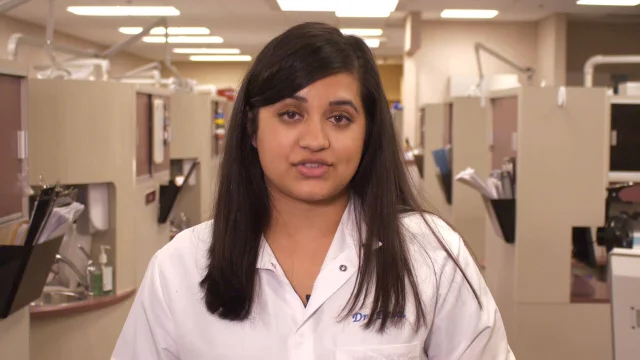By: General Dentist Ekta Desai
Teeth whitening of many kinds have become increasingly popular in recent years. Though our teeth are mostly white overall, tooth enamel can be many shades and can become discolored or stained over time. Teeth may be discolored for a variety of reasons—some in your control and others as a result of injury or illness.
The American Academy of Cosmetic Dentistry asked people what they would like to improve most about their smile and the most common answer was the whiteness of their teeth. Similarly, the American Association of Orthodontics found that nearly 90% of patients requested tooth whitening. So, if you’ve been thinking about whitening your teeth lately, you’re not alone.
If you’re considering teeth whitening, be sure you know the facts about the process and what to expect. You should also check with your dental provider to make sure you’re a candidate for teeth whitening and to learn the best whitening method for your unique situation.
Causes of Discolored Teeth
Over time, you may notice a change in the color of your teeth. This may be happening for one or several of the following reasons:
Food and Drink
Coffee, tea, and red wine are some of the major staining culprits. Their intense color pigments called chromogens attach to the white, outer part of your tooth (enamel) and cause discoloration or staining.
Tobacco Use
Tar and nicotine are the two chemicals in tobacco that lead to tough stains on teeth. Tar is naturally dark, which contributes to staining, while nicotine is colorless until it is mixed with oxygen. Therefore, when the nicotine mixes with oxygen while smoking, it turns into a yellowish substance that is notorious for staining teeth.
Age
Below the tooth enamel, there’s a softer layer called dentin, which is more yellow in nature. Over time, our tooth enamel gets thinner, leading to more of the yellowish dentin showing through the enamel.
Trauma
If you’ve been hit in the mouth or have another type of mouth injury, your tooth may change color because it’s not receiving adequate blood flow anymore. Over time, the tooth may heal itself or it may die altogether. After a mouth injury, it’s always best to have a dentist examine the damage and recommend a treatment plan going forth.
Medications
Some antihistamines, antipsychotics, and high blood pressure medications may have a side effect of tooth darkening. Young children who are exposed to antibiotics like tetracycline and doxycycline during the time their teeth are forming or while in the womb may have some discoloration of their teeth in adulthood. Chemotherapy and neck radiation may also darken teeth.
How Does Teeth Whitening Work?
The process for teeth whitening is fairly simple. Depending on what product you use and if you choose to whiten at home or professionally at the dentist, the steps vary.
Teeth whitening products contain one of two tooth bleaches: hydrogen peroxide or carbamide peroxide. These ingredients work to break stains into smaller pieces and reduce the concentration of color, in turn making your teeth brighter.
Does Teeth Whitening Work on All Teeth?
Unfortunately, whitening does not work on all teeth. Therefore, it’s important to check with your dentist to determine the right procedure for your teeth. Certain whiteners may not correct all types of staining and discoloration. For example, yellowed teeth typically bleach well while brown teeth may not respond as well and teeth with gray tones may not bleach at all.
In addition, whitening won’t work on dental appliances like caps, veneers, crowns, or fillings. It’s highly likely that bleaching your teeth will not be effective if the primary cause for discoloration is medication or trauma
Teeth Whitening Options
There are many options for professional teeth whitening and at-home teeth whitening. Be sure to consult your doctor prior to beginning any treatment plan. Most teeth whitening options fall into one of three categories and range from gentle surface whiteners to stronger ones that can remove deeper stains.
Whitening Toothpaste
Whitening toothpaste works to remove stains on the surface of your teeth. Toothpastes are the gentlest whitener, which is great for those with sensitive teeth. Because they use a polishing action as opposed to bleaching chemicals, whitening toothpastes usually don’t have adverse side effects. However, as a result of their gentleness, they don’t whiten teeth as noticeably as chemical products. It also takes repeated use for whitening toothpastes to show visible results, usually over a period of weeks to months.
At-Home Teeth Whitening
At-home whitening kits can be purchased from your dentist or over the counter. There are many kinds of kits including whitening strips, trays, lights, rinses, and brushes. They usually contain peroxide, which works below the surface to lighten tooth enamel is used regularly over days or weeks.
Your dentist may make a special whitening tray to fit your upper and lower teeth better than one-size-fits-all trays you can purchase at a store. With these custom trays, you’ll squeeze the whitening gel in the trays and wear them for short times during the day or overnight, depending on your dentist’s advice. If you wear the trays for too long, the peroxide in the gel can irritate your teeth and/or gums so be sure to follow your dentist’s instructions.
Professional Teeth Whitening
Professional whitening is done in a dental office. In-office whiteners are much stronger than the other two alternatives because they have more peroxide in the solution. They can change the color of your teeth faster than at-home methods.
The in-office whitening takes about an hour. To help protect the mouth from the peroxide, the gum tissues are covered either with a thin sheet of rubber or a protective gel. Occasionally a light or laser is used in conjunction with the peroxide.
Differences Between Professional Teeth Whitening and At-Home Teeth Whitening
There are several main differences between at-home and professional teeth whitening, but the best course of action depends on the results you’re looking to achieve and your overall oral health.
Time
The amount of time it takes to whiten your teeth at home versus at the dentist’s office to achieve comparable results is significant. At the dentist’s office, you may spend 1-2 hours but leave with teeth 8 shades whiter, whereas at home you will have to spend 1-2 hours per day over a series of days or weeks for your teeth to become 3-6 shades whiter.
Cost
While at home kits average around $50, teeth whitening at the dental office will run closer to $300* or more. The main benefit of professional teeth whitening is that the whitening occurs much faster than the multiple kits often required to achieve and maintain whitening from at-home solutions. With at-home kits, you may also see inconsistent results depending on your teeth and oral health.
Longevity
Since in-clinic whitening can penetrate deeper below the surface of the tooth due to the concentration of the solution, your teeth will stay whiter longer compared to at-home teeth whitening methods.
If you’re interested in having your teeth whitened in our clinic or want to start whitening your teeth at home, schedule an appointment with your provider and see which method is the best for you!
*Cost may vary. Please call your Dental Associates clinic to confirm.
Meet Dr. Ekta Desai
Dr. Desai is a general dentist at Dental Associates Wauwatosa. Get to know her by visiting her profile page: General Dentist Ekta Desai



